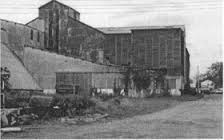History of Central Chemical Corp.
In important ways, the circumstances surrounding Thomas’s entry into the fertilizer business were not propitious. First, Thomas began business near the end of a half-century-long relocation of the fertilizer industry’s center. Though fertilizer use continued to increase in the Mid-Atlantic states and elsewhere during the period from 1870 to 1920, the manufacture of fertilizer began to shift to the Southern states in the late nineteenth century. By 1902, Charleston had replaced Baltimore as the fertilizer capital of the country. The Mid-Atlantic states’ share of total fertilizer use decreased from 34% in 1880 to 14% in 1920. By contrast, in 1920 the South-Atlantic states used about 50% of all fertilizers consumed in the U.S. Thus, Hagerstown could no longer enjoy proximity to the major centers of fertilizer-material production, and, while previously situated between the two highest-fertilizer-use regions of the country, it now found itself on the northern edge of a region that now dwarfed all others.Second, Thomas’s decision to continue in the practice (apparently favored by Hagerstown companies) of making fertilizer primarily from bone and organic materials came at the start of a rapid increase in the demand for mixed fertilizers, but also at the beginning of a precipitous decline in the use of bone and bone products as a source of phosphorous in fertilizers. With the growing use of potash and phosphate rock, consumption of mixed fertilizers grew from 46% of the total in 1880 to around 70% in 1920. During the period from 1890 to 1910, when Thomas was focusing on his presumably unmixed “dissolved bone” fertilizers, mixed fertilizers were capturing market share. Furthermore, the period from 1880 to 1920 is also characterized by the decreasing use of organic materials in general. Though organic materials provided about 91% of the total nitrogen in 1900, by 1917 the total nitrogen contribution from organics had dropped to 46.5%. With regard to phosphates, bone meal, dissolved bones and boneblack, and phosphoro-guano use peaked in 1890, but their use dropped to a negligible amount by 1910 as the use of superphosphates from phosphate rock increased dramatically.. Third, even as Thomas had begun his business trading fertilizer for livestock from relatively distant places, the fertilizer industry was increasingly turning to local distribution. Though mid-nineteenth-century fertilizer plants typically were situated in East Coast harbor cities, twentieth-century plants were dispersed to be closer to areas of consumption. Finally, even though the name “Thomas’ Dissolved Bone” suggests that Thomas produced his own superphosphates initially, the use of bone in the production of superphosphates was on its way out as described above. For all practical purposes, then, Thomas had set his business on the track of the second, smaller type of fertilizer company, which only mixed fertilizer and did not produce superphosphates. For the next 90 years, even when Central Chemical had affiliates across the nation, it would remain in this “smaller” category – relying on large suppliers for its materials. For reasons noted above, this was not a problem at the turn of the century vis-à-vis the larger companies. Starting in the 1890s, however, many agricultural societies began to advocate home mixing of fertilizer materials by farmers. Throughout the first half of the twentieth century, the fertilizer industry fought this effort successfully by insisting on the value of industrial mixing processes and the farmer’s comparative disadvantages in mixing. Though in its early years, Central Chemical advertised itself as “Exporters – Manufacturers – Importers,” by the 1970s it had become little more than a middle-man between larger suppliers and farmers. It did not import its own materials, but purchased granulated materials from suppliers. There is no evidence that Central Chemical was exporting products out of the country anymore. And its manufacturing capacity consisted of mixing pre-processed granulated materials in various proportions. At this point, its consulting capacity became equally important to its factory processes. Though Central Chemical and its subsidiaries were taking in a combined $25 million in sales by the late 1970s, an employee remembers that there was always a sense of trouble on the horizon. The vulnerability of a company that adds very little value to its product and relies entirely on contracts with larger suppliers requires no explanation. It appears that not long after Central Chemical became a bulk blender, its large suppliers began pushing their advantages. In the early 70s, Central Chemical’s supplier, Agrico Chemical Company, put pressure on Central Chemical to enter into a long-term contract. When Central Chemical refused, Agrico withheld di-ammonium phosphate and granular triple super phosphate at a time of national shortage in these materials. Central Chemical responded by filing an antitrust lawsuit against Agrico in federal court. For most of the next decade much of the time, resources, and energy of what was still a closely-held corporation would be consumed in this litigation. Ultimately the lawsuit proved unsuccessful. All of this came at the same time that local, state, federal regulators were investigating the Hagerstown plant for its pesticide-disposal practices. In the 1970s the State of Maryland ordered two separate cleanups of the site; the EPA was just getting started. Ultimately the push to eliminate the middle man that drove the switch to bulk blending began to turn on the blenders themselves. The larger companies and farmers wised up, and realized that they could both save money by dealing directly with each other. Farmers began buying direct-application materials from the same suppliers used by Central Chemical. By the early 1980s, Central Chemical’s network of fertilizer blenders had contracted substantially. Blending operations like those of the Hagerstown plant could no longer make the case for themselves. Crushed under the weight of increasingly serious environmental liability for its mid-century disposal practices, the Central Chemical Corporation contracted its operations substantially. The Hagerstown plant ceased operations in 1984 and the office headquarters moved from the old Thomas building to an office outside Hagerstown. |


